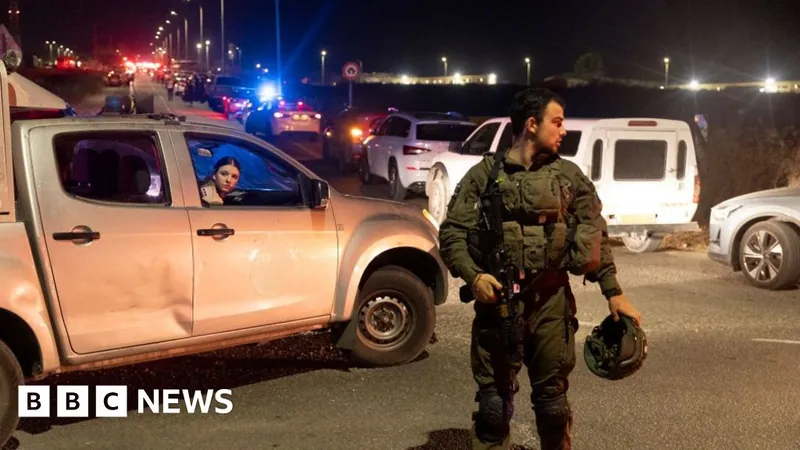
Dramatic Drone Attack in Israel Raises Alarm Over Iron Dome's Vulnerabilities
2024-10-15
Author: Ling
Dramatic Drone Attack in Israel Raises Alarm Over Iron Dome's Vulnerabilities
A recent drone attack by Hezbollah near Binyamina in northern Israel has underscored significant weaknesses in the nation's sophisticated Iron Dome air defense system. This attack, which tragically resulted in the deaths of four soldiers and injured many more, marks one of the most severe drone strikes Israel has faced in its ongoing conflict.
Israeli Defense Minister Yoav Gallant acknowledged the urgency of addressing these vulnerabilities during his visit to the damaged army base the following morning. He stated that "significant efforts" are immediately underway to devise solutions to prevent future drone incursions.
While the Iron Dome has proven effective against the more conventional, crude rockets launched by Hezbollah—boasting a reported success rate exceeding 90%—its efficacy diminishes against drone attacks. According to experts, the challenge with drones lies in their design: they are typically smaller, possess a minimal radar signature, and can fly at low altitudes, making them harder to detect and intercept.
Dr. Yehoshua Kalisky, a senior researcher at the Institute of National Security Studies in Tel Aviv, highlighted that many drones involved in these incursions are manufactured in Iran and supplied to militant groups across Lebanon, Iraq, and Yemen. This strategic partnership increases the frequency of such drone attacks, complicating Israel’s security landscape.
The tactical deployment of drones by Hezbollah has escalated significantly: just this year, drones from Yemen struck Tel Aviv, while an attack from Iraq resulted in the loss of two Israeli soldiers. Moreover, another drone incident last week involved an attack on a nursing home in central Israel, raising serious concerns about civilian safety.
Israeli media reported that two Hezbollah drones, believed to be Ziyad 107 models, successfully crossed into Israeli airspace undetected. One drone was intercepted, while the other crashed after being ignored due to the lack of a warning siren—underlining a gap in real-time monitoring systems.
Input from security analysts, such as Ms. Sarit Zehani of the Alma Research Institute, suggests that the successful penetration of the drones was no coincidence. She asserted that international observation had enabled Hezbollah to plan this drone strike meticulously. Ms. Zehani, residing near the border, reported witnessing an overwhelming barrage of rocket fire during the drone launches, which may have distracted air defense systems.
Since the conflict began a year ago, the Alma Research Institute tallied 559 drone incidents, varying from reconnaissance to direct attacks, with 11 casualties recorded from such operations.
Alongside the Iron Dome, Israel’s air defense arsenal includes advanced systems like David's Sling, Arrow 2, and Arrow 3, specifically designed to address ballistic missile threats. With the forthcoming deployment of a Terminal High Altitude Area Defense (THAAD) battery from the United States, bolstered by nearly 100 U.S. military personnel, Israel is gearing up for a comprehensive defense strategy.
In light of these ongoing threats, researchers are actively developing more autonomous solutions to counter aerial threats. Emerging technologies such as high-powered lasers and microwave cannons are in the works, intended to incapacitate drones before they can inflict harm. Dr. Kalisky indicated that these futuristic defensive technologies could soon become operational, potentially reshaping Israel's aerial defense capabilities.
As tensions escalate and drone warfare becomes increasingly sophisticated, the Iron Dome's limitations have sparked urgent discussions about the future of national security in Israel, marking a turning point in the nation’s defense strategy. Will Israel be able to adapt quickly enough to counter this evolving threat? The next few months may prove crucial.
 Brasil (PT)
Brasil (PT)
 Canada (EN)
Canada (EN)
 Chile (ES)
Chile (ES)
 España (ES)
España (ES)
 France (FR)
France (FR)
 Hong Kong (EN)
Hong Kong (EN)
 Italia (IT)
Italia (IT)
 日本 (JA)
日本 (JA)
 Magyarország (HU)
Magyarország (HU)
 Norge (NO)
Norge (NO)
 Polska (PL)
Polska (PL)
 Schweiz (DE)
Schweiz (DE)
 Singapore (EN)
Singapore (EN)
 Sverige (SV)
Sverige (SV)
 Suomi (FI)
Suomi (FI)
 Türkiye (TR)
Türkiye (TR)